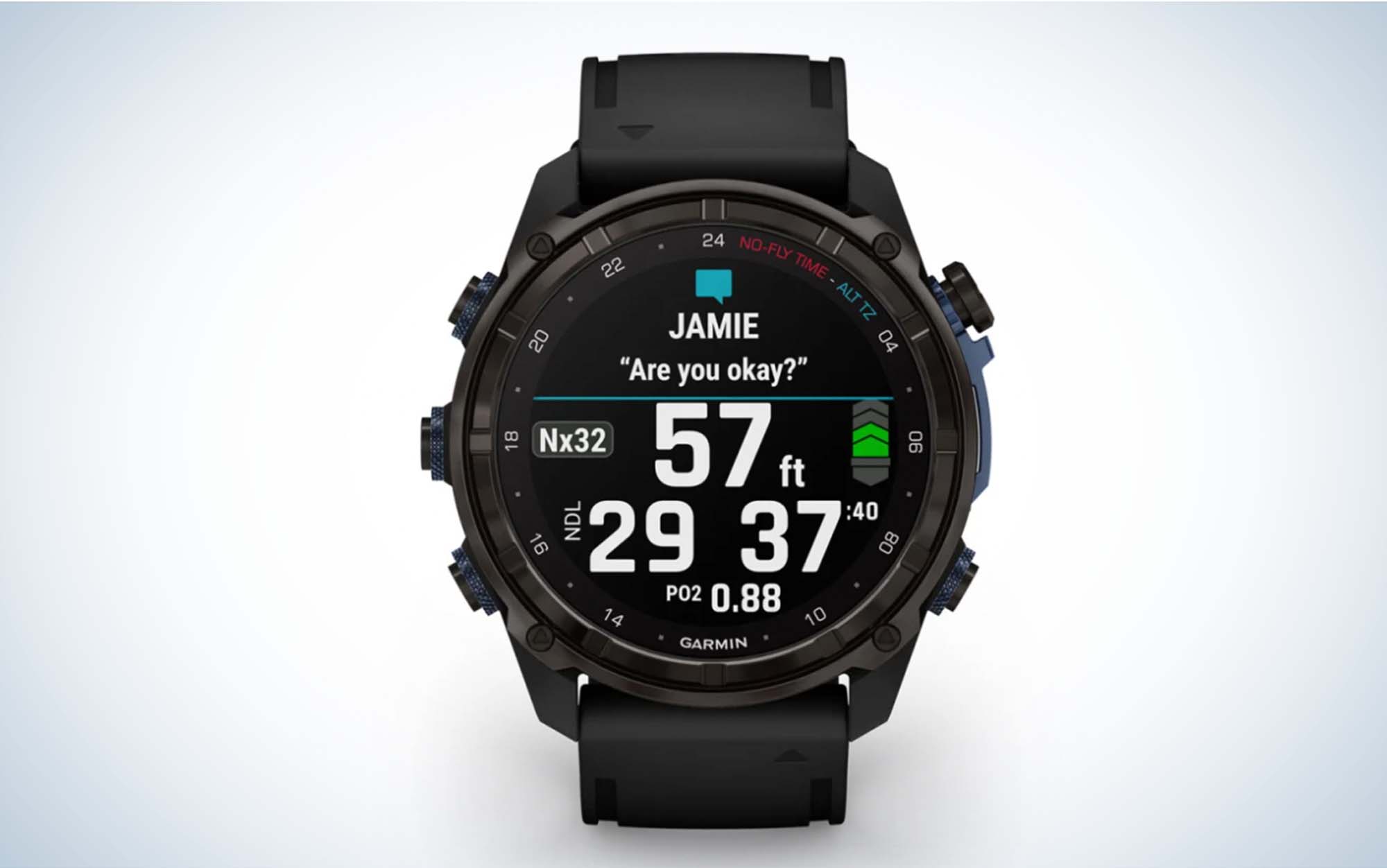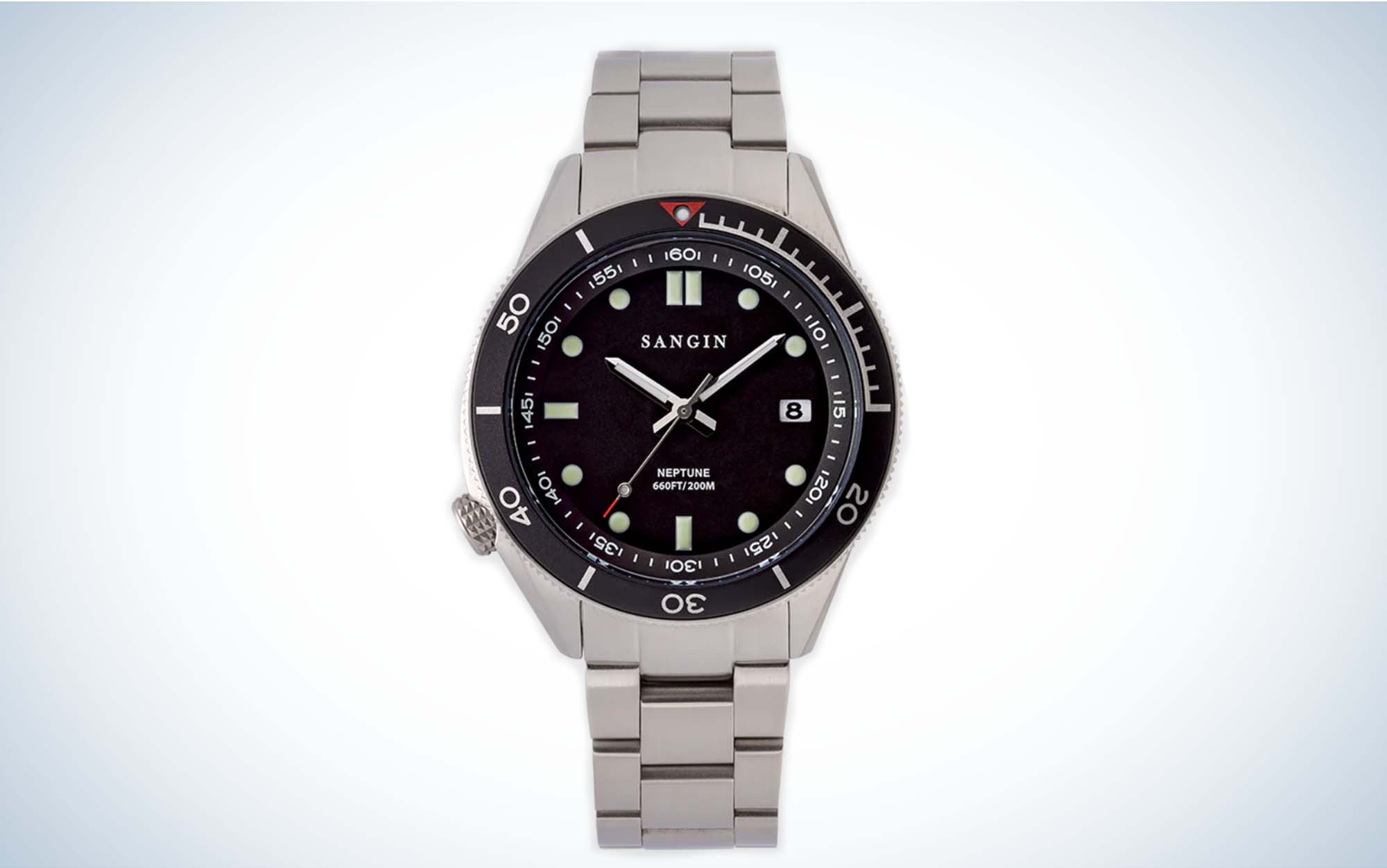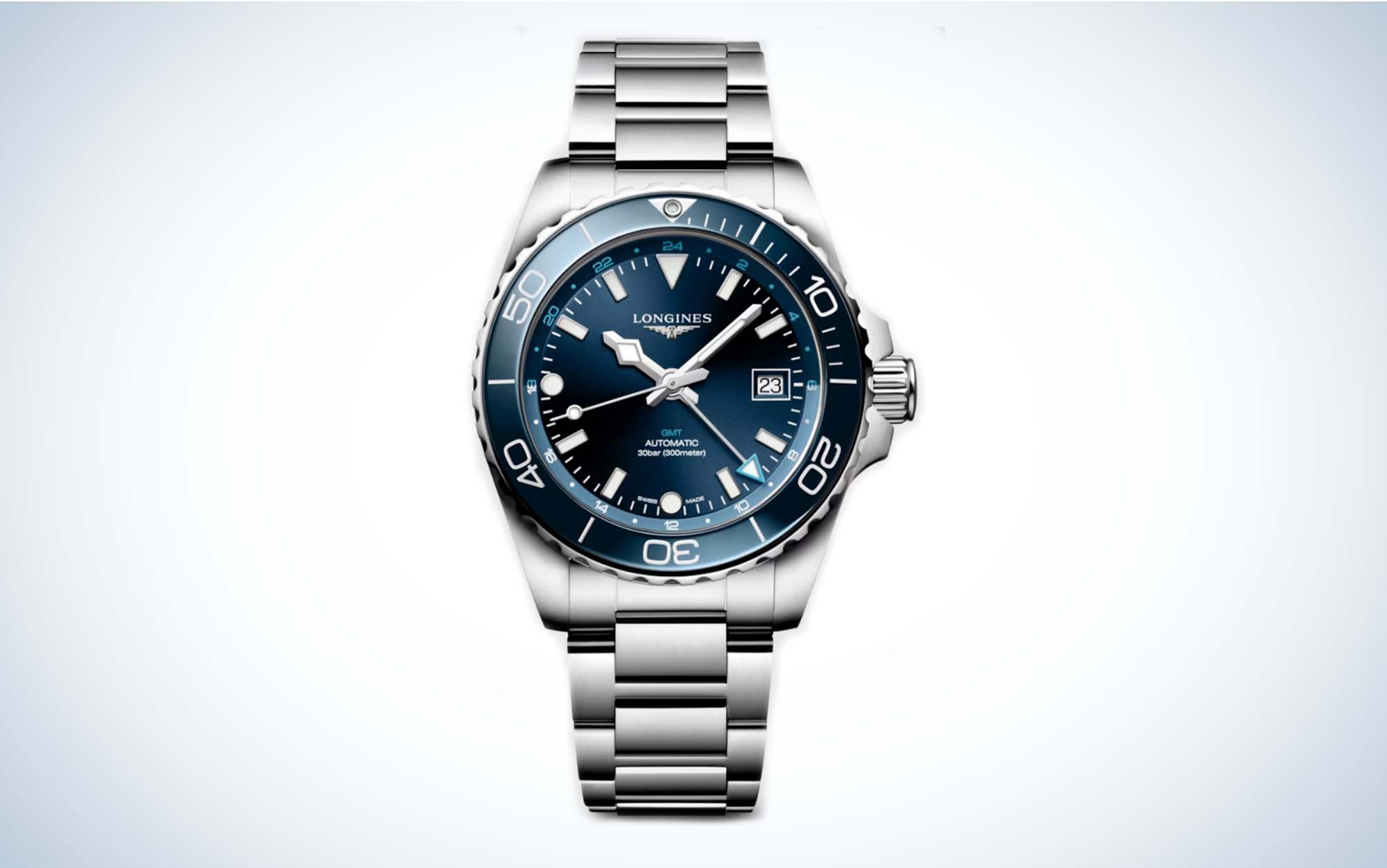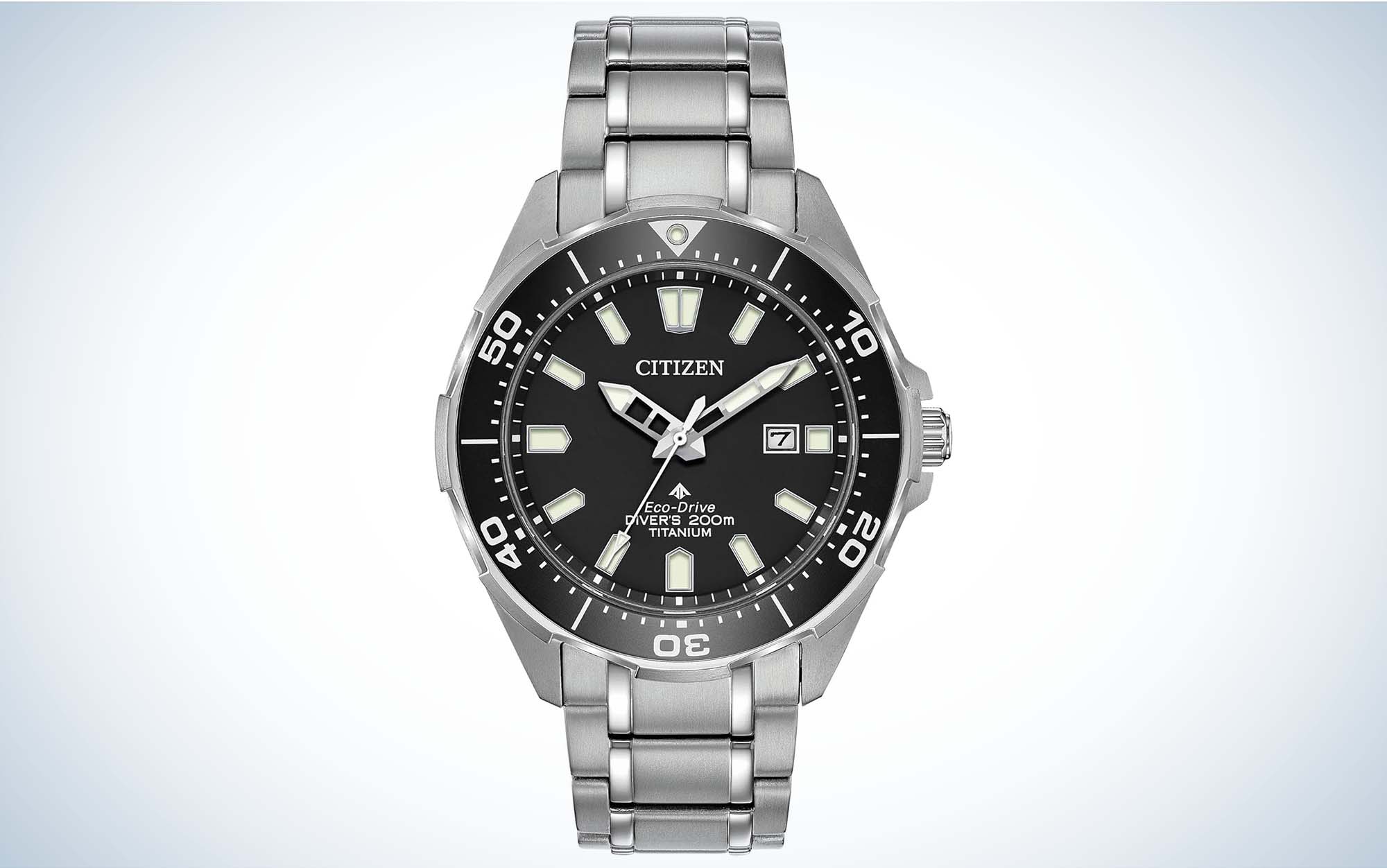We may earn revenue from the products available on this page and participate in affiliate programs. Learn More ›
Dive watches are the ultimate time keeping tool: They’re waterproof, easy to read, illuminated, and have a timing bezel that’s useful for more than decompression stops. I’ve used my dive watch collection to monitor legal shooting light, time dinner in the oven, and make sure I’m on time for the next meeting.
While I’m a watch nerd and love divers, I needed help from someone with serious diving experience to make the best dive watch picks. So I called up watch enthusiast and military diver, Ashley Spurlin, to get his favorites.
Here’s our combined list of the top dive watches across various price points and use cases.
Spurlin’s Picks
Author’s Picks
 The author wearing a Bremont S501 while duck hunting.
The author wearing a Bremont S501 while duck hunting.I think it’s safe to say that if you’re coming to Outdoor Life for a watch recommendation, you want something that’s proven in the field or on the water. That’s why I sought out feedback from someone who has used dive watches for their intended purpose.
Spurlin joined the military in 2000 and still serves as an advisor today. He completed the Combat Diver Qualification Course and has dived throughout the world as an Air Force Combat Controller on a special operations team. In addition to his military diving career, Spurlin grew up diving in Monterey Bay, California, which is one of the nation’s premier diving destinations. He’s also a watch guy, and is passionate about historic military designs and their ties to various military diving communities.
As for me, nearly all the watches in my collection are dive watches, and I’m always looking for one more. Yet, you won’t find my name on a Rolex waitlist. While I admire luxury watches, they’re not in my price range. That’s why my dive watch picks are all value-oriented options. I chose them based on specific budgets, and many of them I’ve owned or are on my want list.
Key Features
Reference Number: M25717N-0001 Fixed Spring Bars Movement: MT5602 (COSC) Titanium case 42mm in diameter 12.75mm thick 52mm from lug to lug 70-hour power reserve Waterproof to 200 meters Ceramic, unidirectional bezel Matte black dial Fabric NATO StrapPros
Durable movement Robust design Lightweight Good illuminationCons
Some users will prefer a watch compatible with a braceletThe FXD, the new black dial FXD in particular, was our unanimous choice as the best overall dive watch. To us, it’s the perfect tool watch and one worth saving up for.
“They hit a home run with that watch: the size of it, how they designed it, why it uses fixed spring bars, and the face is clean and simple. It’s a beautiful, beautiful watch. And it’s attainable by most watch enthusiasts,” Spurlin says.
Spurlin likes that the watch uses a reliable and robust movement, and has a matte, easy-to-read dial. He also appreciates the FXD’s ties to French combat swimmers, and knows of several elite U.S. units that have had special FXDs made for them.
Key Features
Sapphire crystal DLC coated titanium bezel Fiber-reinforced polymer cae with titanium rear cover Battery Life: 25 days (smartwatch) Case Size: 43 or 51mm Waterproof to 200 meters Dive Features: Depth, dive timer, no fly time, air integration, customizable conservatism, dive ascent, safety stop, deep stop, 3-axis dive compass, and much more Compatible with T2 TransceiverPros
A dive computer and daily smartwatch in one Easy dive logsCons
Large watch Requires chargingWhen Spurlin is diving for work his analog diver serves as a backup, and his primary watch is a Garmin Descent. He’s tried a lot of smart dive watches, but likes the Garmin for its ease of use.
“If I’m underwater at night doing a dive, I don’t want to have to look through menus to find the functions I need. I don’t have time for that,” he says. “That Garmin has everything right on the main screen.”
The Descent has a lot of functions for recreational divers and even salvage divers using mixed air. It will time out your air, your decompression stops, and log the dive for you. But, Spurlin’s main use case is navigation.
“You’re hitting the water off a boat, and then you’re on a Draeger or rebreather, and then you’re using your watch to keep time as you’re navigating to your targets,” he says. “And you can put that Garmin watch right next to your dive compass. That thing is always dead nuts.”
Key Features
Case Width: 40mm Lug to Lug Length: 49mm Case Thickness: 13.9mm Lug Width: 20mm Bezel Width: 41mm Case: 316L stainless steel Crystal: Double domed sapphire crystal with a multi-layer blue anti-reflective coating applied to the interior surface of the crystal Luminous: SuperLumiNova BGW9 rated after full charge Bezel: 120-click unidirectional, nickel-edged bezel with aluminum insert Water Resistance: 200m Movement: SII NE15C – manual winding / automatic winding with ball bearing stop second device / Quick date correction / 21,600 bph / ISO 6425 attributes, such as antimagnetic to 4800 Amp and shock-resistant (calibrated in three positions) Power Reserve: 50 hours power reserve (SPRON510 mainspring)Pros
Good quality for the price Clean and functional designCons
Availability is limitedThe MARSOC raider-founded Sangin Instruments offers several watches, but the Neptune is their flagship diver. It comes in at under $1,000 with a SEIKO automatic movement and a rubber dive strap. They also offer it on a bracelet.
“The MARSOC guys do extensive dive operations,” Spurlin says. “Their dive school in Panama City, Florida, is called the Marine Combat Dive Course. So he [Sangin’s founder] knows underwater operations, and he knows exactly what to build at that price point.”
 The author has worn his Sangin Neptune while hunting and fishing throughout the country. Scott Einsmann
The author has worn his Sangin Neptune while hunting and fishing throughout the country. Scott EinsmannI’ve been wearing a Neptune for the last four years, and it has serial number 51. It’s never been serviced and continues to stay within its timekeeping spec. I’ve owned a lot of dive watches, but the Neptune is the one I wear most often because of its clean layout and wearable design.
Spurlin’s current daily wear is a Sangin Professional, which uses a quartz movement and combines a dive watch with a pilot’s watch.
We obviously both love Sangin, but it’s important to know that they are a microbrand that makes their timepieces available by drop. So, you have to sign up for their newsletter or follow them on social media to buy one. When they have stock, their watches typically sell out very quickly. Occasionally they’ll also do pre-orders to alleviate the stress of getting in on a drop.
My interview with Spurlin was equal parts watch talk and military history. He brought up several brands that were new to me and have a rich history or ties with military divers. Here are more of his favorites.
Most watch enthusiasts know of the French Blancpain Fifty Fathoms and its claim as the original dive watch. But, I didn’t know that an American company was secretly supplying a rebranded Fifty Fathoms to the U.S. Military in the 1960s.
“At the time the American commandos wanted the Blancpain Fifty Fathoms,” Spurlin says. “But there was the Buy American Act, which prevented U.S. divers from getting the Fifty Fathoms.”
So an enterprising New York Importer, Allen Tornek, approached Blancpain with the idea of creating a Fifty Fathoms with a USA-based company’s name on it. And so the Tornek-Rayville was born. The Rayville in the name was created as the American-sounding counterpart to the town where the Blancpains were made, Villeret.
An original Tornek-Rayville will set you back well into the six figures at auction. But, you can buy the reissues from Tornek-Rayville for around $1,000.
According to Spurlin, ZRC is a favorite among French combat divers, and it’s one of his favorites because of its unique 6 o’clock crown position.
“They figured out through studies of actual divers, military divers, when they would go to wind their watches sometimes they thought it was closed. And it turns out that it wasn’t closed all the way and then water would get into it,” he says. “If a ZRC’s crown is not closed all the way, you cannot put the watch on. The crown stops the band from wrapping around your wrist.”
Akrone makes field, pilot, and diving watches at affordable prices — most are $550 to $1,300. They have designed several watches in conjunction with the French military, but are relatively unknown in North America.
“We don’t see these watches [Akrone] because we’re not hanging out with French commandos or divers every day,” Spurlin says. “So you don’t hear about this watch company. But it’s like the Sangin watches to French military divers.”
Key Features
Stainless steel and ceramic bezel Sapphire crystal, with anti-reflective coating on both sides Case: 41.00 mm Lug Distance: 21 mm Thickness: 12.90 mm Water-resistant to 30 bar Unidirectional rotating bezel Weight: 180.5 g Caliber: L844 Power reserve up to 72 hoursPros
True GMT movement for an incredible price Highly legible dial layout Well finished Good braceletCons
Additional thickness to house the GMT movementThe Hydroconquest GMT is equal parts dress, tool, and traveler’s watch. It’s also a Longines, which, to me, means value for the dollar. It utilizes Longines’ in-house assembled, true GMT movement, has an impressive 72-hour power reserve, and 300 meters of water resistance. The bracelet has a push-button micro adjust and has a mixture of brushed and polished finishing. The 120-click, unidirectional bezel, has positive clicks and a 12 o’clock lume pip. I love the minimal dial text, which keeps the face legible and clean. While the Hydroconquest GMT isn’t COSC certified it is the same movement you’ll find in the COSC Spirit Zulu Time.
If you don’t need the GMT complication, the standard Hydroconquest costs around $1,200 and is also a great buy.
Key Features
Size 40mm Case Material: Stainless steel Height: 11.3mm Lug-to-Lug: 47.45mm Case Weight: 68 grams Weight inc. strap 160 grams Water Resistance: 30 ATM (300 meters) Movement: Sellita SW200-1 Power Reserve: 38 hours No. of Jewels: 26 Vibrations: 28,800 p/hr (4Hz) Timing Tolerance: +/- 20 sec p/dayPros
Excellent finishing for the price Good bracelet with micro-adjustCons
Low power reserveIf you’re a watch enthusiast who enjoys a watch for more than its ability to tell time, then take a look at Christopher Ward. The watchmakers there are producing some of the best value, especially when it comes to their bracelets and finishing. The C60 Trident Pro 300 is a tool watch with its applied indices filled with lume, easy-to-grip bezel, clean dial layout, and easy-to-service movement. The watch wears small because it’s thin for its depth rating. It has a display caseback, beautiful brushing and polishing, and well-executed bracelet. I like that it comes in a variety of dial colors and is consistently in stock for purchase.
Key Features
Water Resistance: 200 meters Weight: 124.0 grams Unidirectional rotating bezel Screw-down crown Screw case back Caliber Number: 4R36 Movement Type: Automatic with manual winding Precision: +45 to -35 seconds per day Power Reserve: Approx. 41 hours Jewels: 24 Thickness: 13.2mm Diameter: 45.0mm Lug-to-Lug: 47.7mm Sapphire crystal with anti-reflective coating on inner surfacePros
Excellent illumination Time-proven designCons
Some won’t like the “cyclops” day/date windowThe SRPE05 takes the iconic Turtle design and makes some significant upgrades. The upgrades include a sapphire crystal, ceramic bezel, and an improved bezel action. It also sports a waffle dial design. You get all that and SEIKO’s legendary durability in a sub-$500 watch.
Key Features
Case Width: 45 mm Lug Width: 22 mm Water Resistance: 200 meters Mineral crystal Stainless steel Elapsed time bezel; Promaster crown Aluminum bezel; one-way rotating elapsed time bezel E168 Eco-Drive Powered by any light source, continuously and sustainably, eliminating the need to replace watch batteries.Pros
Reliable AccurateCons
Strap isn’t ideal for daily wearThe Promaster is an ISO compliant dive watch that will run forever. The Citizen Eco-Drive is a unique movement that can run indefinitely as long as it is exposed to a light source. You don’t have to worry about winding it or changing batteries. It comes with an extra-long strap for fitting over your wetsuit.
Key Features
Stainless steel case Aluminum bezel Unidirectional bezel 200-meter water resistance Three-year battery life with a SR626SW Accuracy: ±20 seconds per monthPros
Clean and easy-to-read design Comfortable for daily wearCons
Strap could use upgradingThe Casio Duro has achieved legendary status by being a sub-$100 watch with 200 meter water resistance and an accurate quartz movement. It’s well regarded by divers and watch collectors as one of the best value divers.
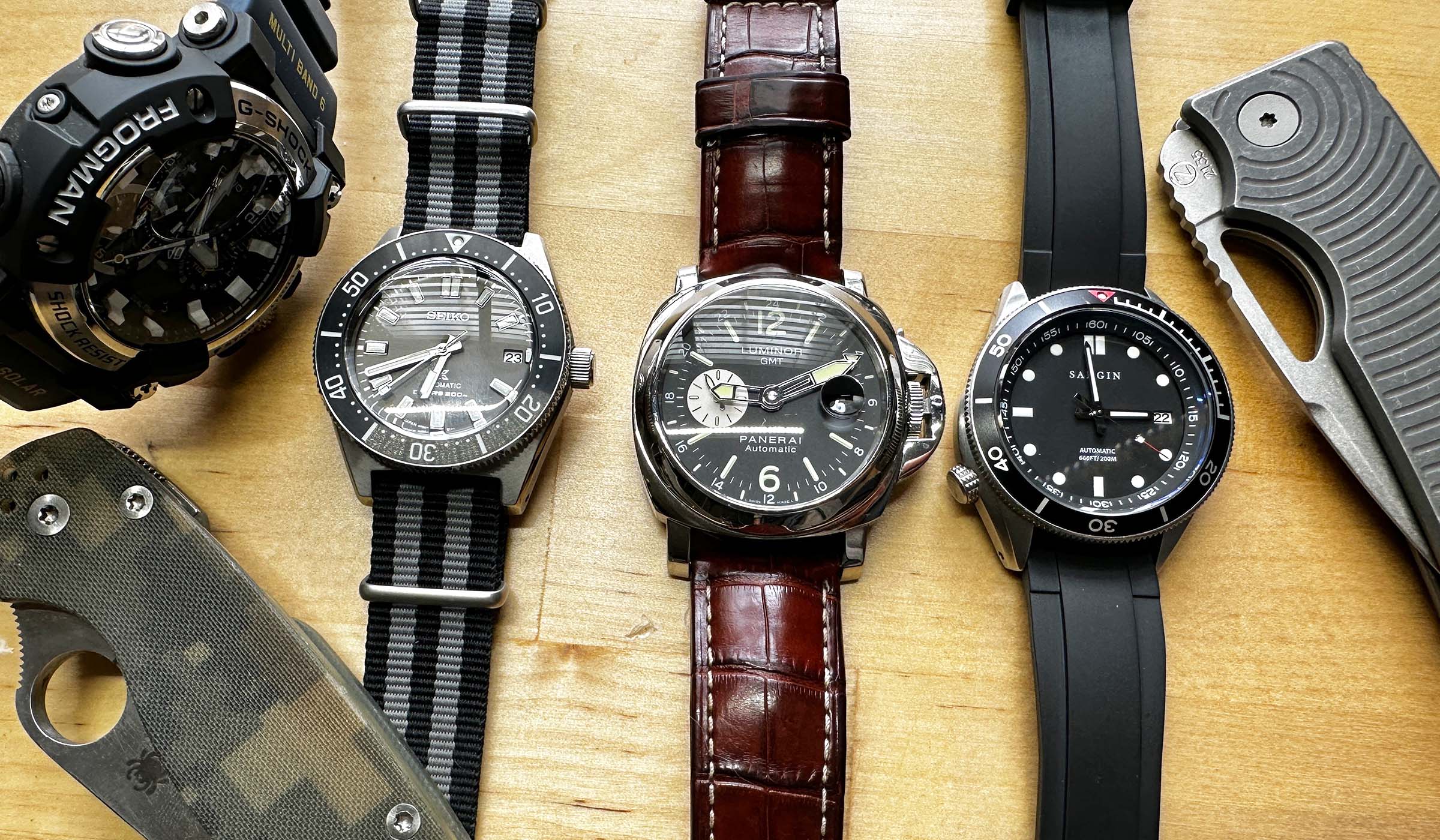 A watch should match your lifestyle and your budget. Scott Einsmann
A watch should match your lifestyle and your budget. Scott EinsmannWhen I first started collecting, I was obsessed with accurate automatic movements. Now I realize it’s not a big deal if my watch is off 30 seconds per day or 30 seconds per month. I can easily reset the watch every few weeks. If you truly care about time-keeping accuracy, a quartz movement is far superior to any mechanical watch.
What I do care about in my movements is their ability to resist magnetization and withstand shock. Both can affect your watch’s function. Magnetization commonly happens from being exposed to electronics, like the laptop I type on all day. Shock from shooting a gun or swinging a hammer can also damage intricate mechanical movements.
Manufacturers are fortifying their movements to withstand that type of daily abuse. Bremont, for example, uses a Faraday cage around the movement and designs their watches to withstand severe shock. Other manufacturers use things like silicon hairsprings to prevent magnetization.
Another feature I look for in a movement is ease of service. Exotic, in-house movements are cool, but there’s something to be said for being able to easily find a part or even have a movement swapped for very little money.
In my opinion, 200 meters of water resistance is more than enough. If you’re a salvage diver, then maybe you’ll use 300+ meters of water resistance. For the rest of us, it’s just a cool feature we won’t use.
It’s safe to say that most dive watches made today will never reach a depth beyond the deep end of a pool. That’s because divers now use dive computers or smart watches like the Garmin Descent. Yet, Spurlin says mechanical timepieces still have a role.
“In my opinion, I would say that they do still fill a role for military divers,” he says. “Yes, we want the computer because it makes life easier and it’s awesome. But, when you’re 30 or 200 feet underwater, and your computer fails, which could happen, you better have a backup plan. And the backup plan is the simplest most rudimentary thing that always is there and always works — your watch.”
From retro 60s divers to modern tool watches, I think dive watches are unmatched in their aesthetic and practicality. The problem is there are thousands available, and new microbrands are popping up all the time. How do you figure out the right one to buy?
I follow the advice I heard from watch designer George Bamford, “buy a watch that makes you smile.” While watches are practical, they’re also deeply personal, and you have to like what’s on your wrist.



